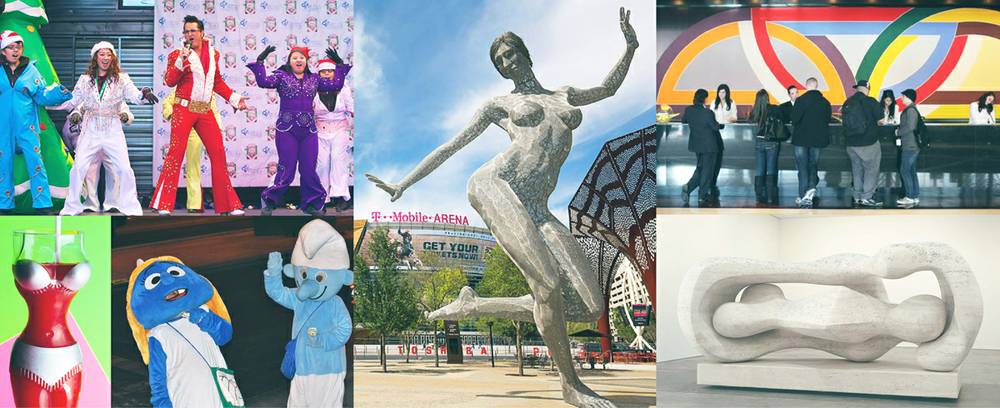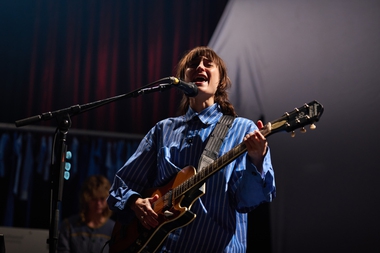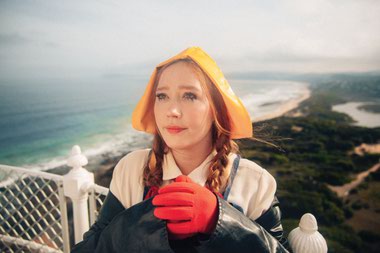A meteor struck the Las Vegas arts community last week in the form of a 40-foot naked woman, prompting a diabolical social-media exchange between members of an already divided scene on the role of art in a society. The catalyst? A free-spirited playa nymph, barefoot and dancing in a corporate plaza on Las Vegas Boulevard.
Aptly titled “Bliss Dance,” the installation was originally created for Northern Nevada’s Burning Man festival by artist Marco Cochrane to represent female strength, expression and protection—a sentiment that has had Jim Murren, chairman and CEO of MGM Resorts International, enthusiastically sharing its message now that she’s anchoring MGM’s Park adjacent to the new T-Mobile Arena. But it was only a matter of time before “Bliss Dance” was derided by dissenters as bad art, a glorified light-up nude. Now that the Strip has works by James Turrell, Jenny Holzer, Maya Lin, Frank Stella and Nancy Rubins, some argue that the bar has been raised. We’ve gone beyond mere kitsch and shrimp cocktail.
But when one chunk of the arts community (including professional critics and curators) lamented the quality of “Bliss Dance” on Facebook, the rebuttal came full-force from those believing the comments to be unkind, disappointing and most of all, “elitist.”
“Art serves a community best when all aspects of it thrive and grow,” says arts advocate Brian “Paco” Alvarez, who champions “no-brow” art and says he was disheartened by the debate. “Let’s support it at all its levels. We need to build it up and not break it down.”
Still, there are gifted athletes and average ones, good musicians and amateurs, excellent restaurants and bad ones. “Why should art, of all things, be free from critical dissection?” asks Michele Quinn, owner of Michele C Quinn Fine Art Advisory, who was part of bringing in CityCenter's $40 million art collection featuring works by Lin, Rubins, Holzer and others. “As art students you are put through critiques and other people give their input because it helps the artist understand the process and how to make their work better. It’s not always based on like and not like, and not popular opinion but the artistic merits: ‘This works because of X, Y, Z.’
“Art isn't subjective,” Quinn continues. “If art is subjective, why do museums exist? Art should go beyond the superficial otherwise it has no soul. It’s not meant to be a superficial quick-glance response. A Donald Judd is not just a box, but an analysis of shape and form, a mathematical structure.”
To that, the mainstream scoffs. How many times have you heard someone say that their kid or Chihuahua could do that when looking at a monochromatic painting, soil installation or fabric dangling from a gallery ceiling? But like a pop song on the radio, “Bliss Dance” is not that. There’s no real mystery here playing out on seven different levels. This is primal and immediate—some might say “easy listening” rather than Wagner.
“It’s part of a larger creative class,” says Patrick Duffy, an art collector and philanthropist and board president of the Las Vegas Art Museum, which houses its collection at the Barrick Museum. “There’s the academic, which has tremendous value in contributing to that creative class. Then you have a portion that is more decorative that has a lot more to say to a greater portion of the community.
“Las Vegas, at this point, should never be highbrow,” Duffy says. “We haven’t arrived yet. In this city, if we put on a Robert Ryman show and we ran through all the people who went to [the Park], the comments would likely be negative. When I see [recent UNLV MFA grad] Audrey Barcio’s work, it is a beautiful and intellectual installation. ‘Bliss Dance’ has a larger beauty component for the masses. Our community is made up of John Q. Publics, not UNLV MFAs. The more the molecule knows that the mountain is bigger than the molecule, the better off we’d be.”
When arguing for positive change in Las Vegas’ arts scene, both sides of this debate sincerely believe that is what they’re doing. The notion of “dumbing down society to mediocrity” (an excerpt from the Facebook thread) in the context of aesthetics and art might be part of a spirited and lively discussion somewhere else. Here, it’s a personal dagger to those advocating for a sort of cultural socialism, where everything and everyone is supported. Criticism spoils that stew, some insist. Over the years, some artists and gallery owners have questioned why we even need art critics. Yet there are food critics, music critics, book critics and so on. Quinn asks, “Is a paragraph good just because it has words in it?”
The debate about “Bliss Dance” reduces to whether it fits in the fine-art category.
“‘Bliss’ is primed for popular consumption, easily digestible and the perfect setting for a striking selfie,” says Danielle Kelly, former art critic for Las Vegas Weekly, who received her MFA from UNLV before serving as executive director of the Neon Museum until last year. “She is carefree and fun, not boring and serious, striking a lovely mood in the newest amenity in the heart of the Strip. She is a perfect marketing tool. High art, she is not.
“'Bliss’ is a very nice figurative sculpture that has absolutely no interest in redefining perceptions of the female form in public art or sculpture; it doesn’t speak to a lineage of the female nude (apart from actually being one); it doesn’t engage in any sort of dialogue with contemporary art; it doesn’t change how we think about materials or form; it is not genre-defining or gender-bending. She is, pardon the pun, blissfully unaware of the last 200 years of art history. It is public art for a transient art city in the middle of the desert, a big, beautiful life-affirming party city. Stripped of the symbiosis of Burning Man, she must contend with a far less humble setting.”
The setting is what throws off some of the installation’s critics. “One of the principles of Burning Man is de-commodification. By taking the sculpture off the playa and placing it in a commercial space, it has lost its relevance,” says Barrick Museum Program Director Aurore Giguet, adding that she speaks only for herself. “Good public art, whether part of a municipal or corporate collection, is a reflection of how we see the world and our city. It can enhance the environment or transform a landscape, heighten our awareness or make us question our assumptions.”
Kelly says, “The persona of ‘Bliss’ and its significance as an object are both utterly lost on the Las Vegas Strip—the competition is too fierce. Its majesty relies on the context of the playa, the magic of Burning Man that gave birth to her luminous form. Her towering, bare honesty and buoyant body speak to both the spirit of the event and its art-making, as well as the joy of its participants.”
Las Vegas’ reputation as an international tourist destination pandering to the mainstream suffers no great blow here. We’re already mocked for being cheesy capitalist America run amok, placing the superficial on an imitation gold stage and praising it with corporate-branded yard-long drink containers. This debate is more about the heart of the arts community and its potential.
“This is where the lack of critical understanding becomes such a burden on Vegas, when we are afraid to say anything bad,” artist Erik Beehn stated in the Facebook thread. “I think the most disappointing part of all this is that we still have to have this conversation. How come anyone having a reaction that is critical is looked at as being mean or elitist?”
There are those who believe art’s very nature should engender criticism, discussion, dialogue and debate, that it should be an intellectual pursuit. They may continue to vent their frustration over the “no-brow” sentiment, and the other half may get offended. The beauty is that in a city believed to be culturally vacant, transient and not invested in the community, this dialogue proves otherwise.








